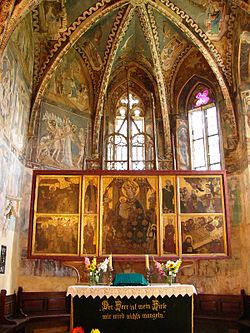- Laslea
-
Laslea — Commune — Coordinates: 46°13′N 24°39′E / 46.217°N 24.65°E Country  Romania
RomaniaCounty Sibiu County Population (2002)[1] 3,203 Time zone EET (UTC+2) – Summer (DST) EEST (UTC+3) Laslea (German: Grosslasseln; Hungarian: Szászszentlászló) is a commune located in Sibiu County, Romania. It is composed of five villages: Floreşti (Felsendorf; Földszin), Laslea, Mălâncrav (Malmkrog; Almakerék), Nou Săsesc (Neudorf; Apaújfalu) and Roandola (Rauthal; Rudály).
At the 2002 census, 65% of inhabitants were Romanians, 23.9% Roma, 9.7% Germans and 1.3% Hungarians. 76.2% were Romanian Orthodox, 7.2% Pentecostal, 5.7% Evangelical Lutheran, 5.2% Seventh-day Adventist, 2.6% Evangelical Church of Augustan Confession and 1.2% Baptist.
Contents
Villages
Mălâncrav is a village in Laslea commune. A dirt road of 10 km leads to the village. It was originally populated by Transylvanian Saxons.
Here are found the most significant Gothic murals in Transylvania aside from those at Ghelinţa in Covasna County.
The Saxon Romanesque Lutheran church has early 14th century Gothic murals in the apse, 15th century ones in the nave and a 15 century late Gothic altar.
In later centuries the Apafi clan (Hungarian nobles in Transylvania) buried their dead in the church since they had overlordship in the village, but the sarcophagi were removed by the Communist regime. The locality was not part of the autonomous Saxon territory, although until the 1970s it was populated by Germans.
Prince of Wales and sustainable tourism
In 2006, The Prince of Wales bought and restored two 18th century Transylvanian Saxon houses in the villages of Mălâncrav and Viscri to help protect the unique way of life that has existed for hundreds of years and promote sustainable tourism.
The buildings have been sensitively restored and converted into guesthouses for tourists. They remain in keeping with the surrounding architecture and feature a number of Transylvanian antiques but with modern facilities where possible.
The renovation of these buildings has helped provide a sustainable future for the people of rural Transylvania while also enabling residents to maintain their traditional way of life.
Mălâncrav church gallery
-
Holy Hungarians, Bishop Gellert, Ladislaus I of Hungary, Unknown, Stephen I of Hungary, his son Holy Prince Emericus
Sibiu County, Romania Cities 
Towns Agnita · Avrig · Cisnădie · Copşa Mică · Dumbrăveni · Miercurea Sibiului · Ocna Sibiului · Sălişte · Tălmaciu
Communes Alma · Alţâna · Apoldu de Jos · Arpaşu de Jos · Aţel · Axente Sever · Bazna · Bârghiş · Biertan · Blăjel · Boiţa · Brateiu · Brădeni · Bruiu · Chirpăr · Cârţa · Cârţişoara · Cristian · Dârlos · Gura Râului · Hoghilag · Iacobeni · Jina · Laslea · Loamneş · Ludoş · Marpod · Merghindeal · Micăsasa · Mihăileni · Moşna · Nocrich · Orlat · Păuca · Poiana Sibiului · Poplaca · Porumbacu de Jos · Racoviţa · Răşinari · Râu Sadului · Roşia · Sadu · Slimnic · Şeica Mare · Şeica Mică · Şelimbăr · Şura Mare · Şura Mică · Tilişca · Târnava · Turnu Roşu · Valea Viilor · Vurpăr
Coordinates: 46°13′N 24°39′E / 46.217°N 24.65°E
References
- ^ Romanian census data, 2002; retrieved on March 1, 2010
Categories:- Communes in Sibiu County
- Medieval architecture
- Gothic architecture in Romania
- Sibiu County geography stubs
- Hungarian history stubs
Wikimedia Foundation. 2010.












